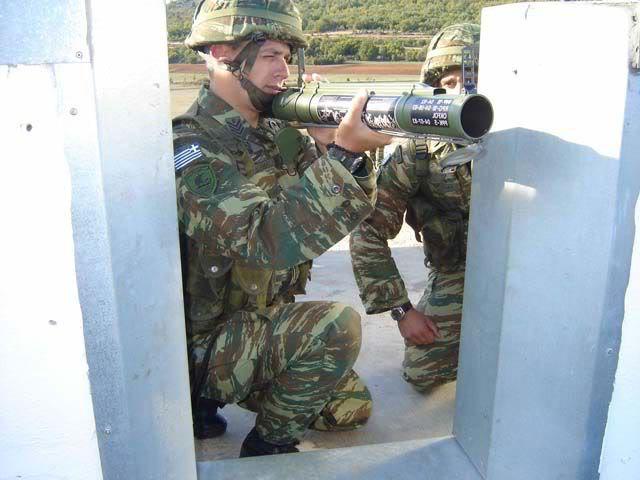Soviet designers Baraboshkin V.I. and Rogozin I.E., during lengthy and detailed developments, invented the first RPG-18 anti-tank grenade with a single use. After passing the tests at the test site in 1971, the question arose of the adoption of this system by the Soviet Army. In 1972, the RPG-18 replaced the Soviet- era anti-tank hand grenade RKG-3. During the tests, the name of the RPG-18 "Fly" was assigned to the new grenade - due to the peculiar device of the front sight.
A distinctive feature of the RPG-18 from the "Miniman" grenade launcher made in Sweden, which was in service with many armies of that time, was that it was equipped with a rocket-propelled grenade. The projectile was designed to perform shots from a prone position, as well as from the knee and shoulder. Today you can also buy RPGs. Photos taken with him evoke various emotions.
Device description
The presence of a jet engine has become an important aspect in the context of the priority of this type of weapon. The barrel of the device consists of two pipes entering each other according to the principle of a telescope. The material of the pipe located outside is T13 fiberglass with varnish impregnation (EP-5122 varnish grade); the material of the pipe inside is aluminum alloys of grades 65KhZAMg6M or 65KhZD1T. The total length of two pipes nested in each other is 705 millimeters; when shooting, the total barrel of two extended pipes is 1050 millimeters.
Principle of operation
When the pipes diverge for firing at the RPG-18, the grenade occupies a fighting position in the part of the barrel located behind the shooter’s back. To transfer the RPG-18 to the combat position, it is necessary to push the pipes apart. The correctness of their separation occurs due to the presence of a rigidly fixed ruler, which moves linearly along the groove of the pipe body located outside. The purpose of the ruler in the folded state is to hold the lock of the protective cover and sighting sight in the lowered position. In preparation for firing, the entire mechanism is triggered and the diopter is released.

The direction of the internal RPG pipe (photo of the structure can be found on some technical sites of the military direction) when transferring the grenade launcher to the firing position provides a guide ruler riveted to its rear end. During the traveling movement of the RPG-18, this element of the mechanism is located in a special guide casing, having the form of a trough, on top of the outer pipe. The front of the ruler protrudes from the casing and grips the mechanism to hold the front sight and cover to stay in the closed position. To extend the pipes, it is necessary to open the back cover, while the ruler moves back along the groove of the casing, unlocking the holding mechanism. There is a rise of the front sight and a simultaneous reset of the cover. At the same time, a spring-loaded diopter also rises.
Special plates hold the grenade by the stabilizer in a fixed position in the inner tube body. When the grenade moves, the plates are destroyed and uncoupled from the stabilizer feather when the grenade leaves the common pipe. In the rear compartment of the inner tube are a capsule for igniting a grenade, a striking mechanism and a mechanism that blocks a grenade from being shot accidentally.
Front sight
The diopter, parts of the descent mechanism, as well as the front sight, with a folding position, are located on the pipe located outside. The aiming device has two main elements - the front sight and the diopter, thanks to which the shooter can conduct aimed fire at the target. Using a special digital marking on the front sight, the shooter can determine how far the armored vehicle is. For example, a tank is in the form of a target. If his silhouette fits into the connector between the near and far risk at the level of the mark "15", then the distance to the target is 150 meters.
Specifications RPG-18
To bring the grenade launcher into a combat state, it takes from 8 to 10 seconds. The grenade is capable of piercing up to 300 mm of armored steel. The grenade caliber is 64 mm. The initial velocity of the grenade upon exiting the barrel is 114 m / s. At the same time, the flight range in a straight line is 135 m, and the aiming range is 200 m. The mass of the RPG-18 in combat condition is 2.6 kilograms.
Grenade PG-18
The PG-18 grenade has a jet engine and a caliber warhead. In a jet engine concentrated reactive charge of gunpowder PPK-5. The explosive Okfol was used for an explosive projectile - a mixture of chemical compounds capable of detonation under certain conditions. Okfol weighing 312 grams was located in the main part of the grenade.
Modern combat weapons
RPG-18 was produced until 1993, after which its release was discontinued. He was replaced by the RPG-22, although the release of this grenade launcher was launched back in 1979. This is a disposable military weapon of Russia, and the principle of its operation is similar to RPG-18. Perhaps this is precisely what served at that time as the main reason for the discontinuation of the RPG-18. The most modern grenade launchers in the Russian army are the RPG-30 “Hook” (single use), the DP-65 grenade launcher system (remote-controlled), as well as various options for grenade launchers. Even the most militarized states are afraid of many of them.